当前位置:网站首页>OpenGL - Lighting
OpenGL - Lighting
2022-07-05 09:18:00 【Farmer er】
We see in real life that the color of an object is not the color that the object really has , But what it reflects (Reflected) Color . let me put it another way , Those that cannot be absorbed by objects (Absorb) The color of is the color of the object we can perceive .
The simple understanding is RGB Multiplication of components :
glm::vec3 lightColor(0.33f, 0.42f, 0.18f);
glm::vec3 toyColor(1.0f, 0.5f, 0.31f);
glm::vec3 result = lightColor * toyColor; // = (0.33f, 0.21f, 0.06f);
To simulate a more realistic lighting effect , according to Feng's illumination model (Phong Lighting Model) It is divided into The ambient light (Ambient Lighting)、 Diffuse reflection (Diffuse Lighting) and Specular reflection (Specular Lighting).
Ambient lighting
One property of light is , It can diverge in many directions and bounce , So that we can reach points that are not very directly adjacent . therefore , Light can be reflected on other surfaces , Have an indirect effect on an object . We use a small constant ( light ) Color , Add to the final color of the object segment , In this way, even if there is no direct light source in the scene, it can appear that there is some divergent light .
// fragment shader
void main()
{
float ambientStrength = 0.1;
vec3 ambient = ambientStrength * lightColor;
vec3 result = ambient * objectColor;
FragColor = vec4(result, 1.0);
}
Diffuse lighting
For calculating diffuse reflection , We need to know :
- The normal vector (
Normal vector): A vector perpendicular to the vertex surface . - Directional light (
The directed light ray): The direction vector as the vector difference between the position of the light source and the position of the clip .
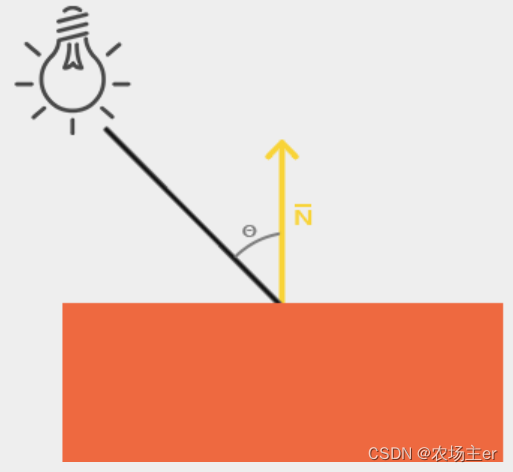
For specific calculation examples, please refer to ->
The normal vector acts in the world coordinate system , In order to solve the problem that the normal vector is not perpendicular to the surface caused by the non proportional scaling of the object , Can pass Normal matrix (Normal Matrix) Correct this behavior :
Normal = mat3(transpose(inverse(model))) * aNormal;
Specular Lighting
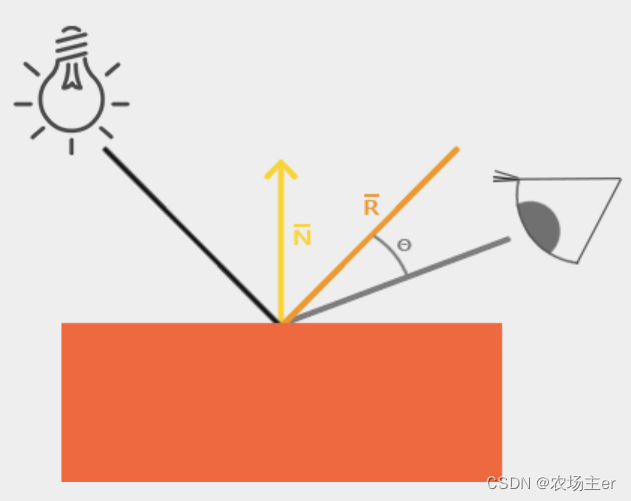
Just like diffuse lighting , Specular illumination also depends on the direction vector of light and the normal vector of the object , But it also depends on the direction of observation , For example, in what direction does the player look at this clip . We calculate the reflection vector by inverting the direction of the incident light according to the normal vector . Then we calculate the angle difference between the reflection vector and the viewing direction , The smaller the angle between them , The greater the effect of mirror light . The result is , When we look at the reflection direction of the incident light on the surface , You'll see a little highlights .
To calculate the reflection vector, you can use reflect( The light source points to the vector of the clip , The normal vector ), To calculate the mirror component, you can use :
// This 32 value is the shininess value of the highlight.
float spec = pow(max(dot(viewDir, reflectDir), 0.0), 32);
vec3 specular = specularStrength * spec * lightColor;
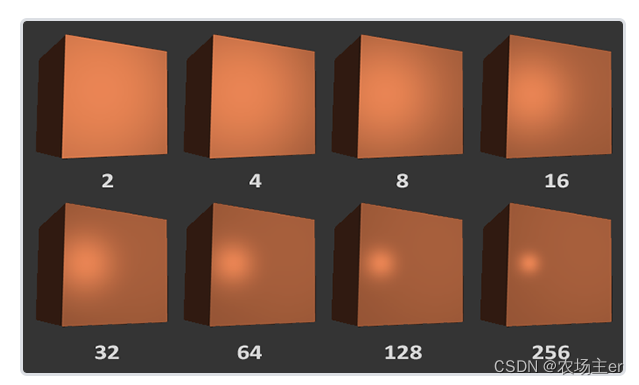
Integrate three lighting effects to superimpose , The final code can refer to ->
Materials
In the real world, different objects behave differently under the same light source , The reason is that the materials are different :
#version 330 core
struct Material {
vec3 ambient;
vec3 diffuse;
vec3 specular;
float shininess;
};
For light sources , The influence proportions of the three attributes on objects are also different :
struct Light {
vec3 position;
vec3 ambient;
vec3 diffuse;
vec3 specular;
};
Combine the two structures , The actual color of the object is calculated as follows :
in vec3 FragPos;
in vec3 Normal;
uniform vec3 viewPos;
uniform Material material;
uniform Light light;
void main()
{
// ambient
vec3 ambient = light.ambient * material.ambient;
// diffuse
vec3 norm = normalize(Normal);
vec3 lightDir = normalize(light.position - FragPos);
float diff = max(dot(norm, lightDir), 0.0);
vec3 diffuse = light.diffuse * (diff * material.diffuse);
// specular
vec3 viewDir = normalize(viewPos - FragPos);
vec3 reflectDir = reflect(-lightDir, norm);
float spec = pow(max(dot(viewDir, reflectDir), 0.0), material.shininess);
vec3 specular = light.specular * (spec * material.specular);
vec3 result = ambient + diffuse + specular;
FragColor = vec4(result, 1.0);
}
Lighting maps
In the last section, the color of diffuse and specular reflection in the material is the same for the whole object , If you apply texture to reflection , It can be called diffuse map and specular map . The ambient color is equal to the diffuse color in almost all cases , So we don't need ambient light mapping .
For specific examples, please refer to ->
Light casters
In the real world , We have many kinds of light , Each performance is different . Project light (Cast) The light source to the object is called Projector (Light Caster).
Directional Light
When a light source is far away , Each ray from the light source will be approximately parallel to each other , Only the direction of the light source is needed to simulate the directional light .
struct Light {
// vec3 position; // Using directional light is no longer needed
vec3 direction;
vec3 ambient;
vec3 diffuse;
vec3 specular;
};
...
void main()
{
vec3 lightDir = normalize(-light.direction);
...
}
Point lights
A point light is a light at a certain position in the world , It will shine in all directions , But as the distance of light propagation increases , Will gradually reduce the intensity of light , be called attenuation (Attenuation), Rules are as follows :
Due to the existence of quadratic terms , Light will decay in a linear manner most of the time , Until the distance becomes large enough , Let the second term exceed the first term , The intensity of light decreases at a faster rate . This is the result , Light is very bright at close range , But as the distance increases, the brightness decreases rapidly , Finally, the brightness will be reduced at a slower speed . The picture below shows the following in 100 The effect of attenuation within a distance :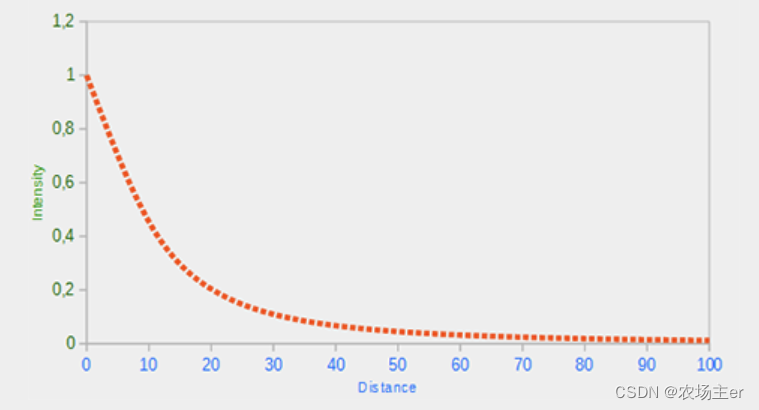
As for how to choose these constant terms , You can refer to ->
The code implementation is as follows :
#version 330 core
out vec4 FragColor;
struct Material {
sampler2D diffuse;
sampler2D specular;
float shininess;
};
struct Light {
vec3 position;
vec3 ambient;
vec3 diffuse;
vec3 specular;
float constant;
float linear;
float quadratic;
};
in vec3 FragPos;
in vec3 Normal;
in vec2 TexCoords;
uniform vec3 viewPos;
uniform Material material;
uniform Light light;
void main()
{
// ambient
vec3 ambient = light.ambient * texture(material.diffuse, TexCoords).rgb;
// diffuse
vec3 norm = normalize(Normal);
vec3 lightDir = normalize(light.position - FragPos);
float diff = max(dot(norm, lightDir), 0.0);
vec3 diffuse = light.diffuse * diff * texture(material.diffuse, TexCoords).rgb;
// specular
vec3 viewDir = normalize(viewPos - FragPos);
vec3 reflectDir = reflect(-lightDir, norm);
float spec = pow(max(dot(viewDir, reflectDir), 0.0), material.shininess);
vec3 specular = light.specular * spec * texture(material.specular, TexCoords).rgb;
// attenuation
float distance = length(light.position - FragPos);
float attenuation = 1.0 / (light.constant + light.linear * distance + light.quadratic * (distance * distance));
ambient *= attenuation;
diffuse *= attenuation;
specular *= attenuation;
vec3 result = ambient + diffuse + specular;
FragColor = vec4(result, 1.0);
}
Spotlight
A spotlight is a light source located somewhere in the environment , It shines light in only one direction, not all directions . The result is that only objects within a specific radius in the direction of the spotlight will be illuminated , Other objects will remain dark . A good example of spotlight is a street lamp or flashlight .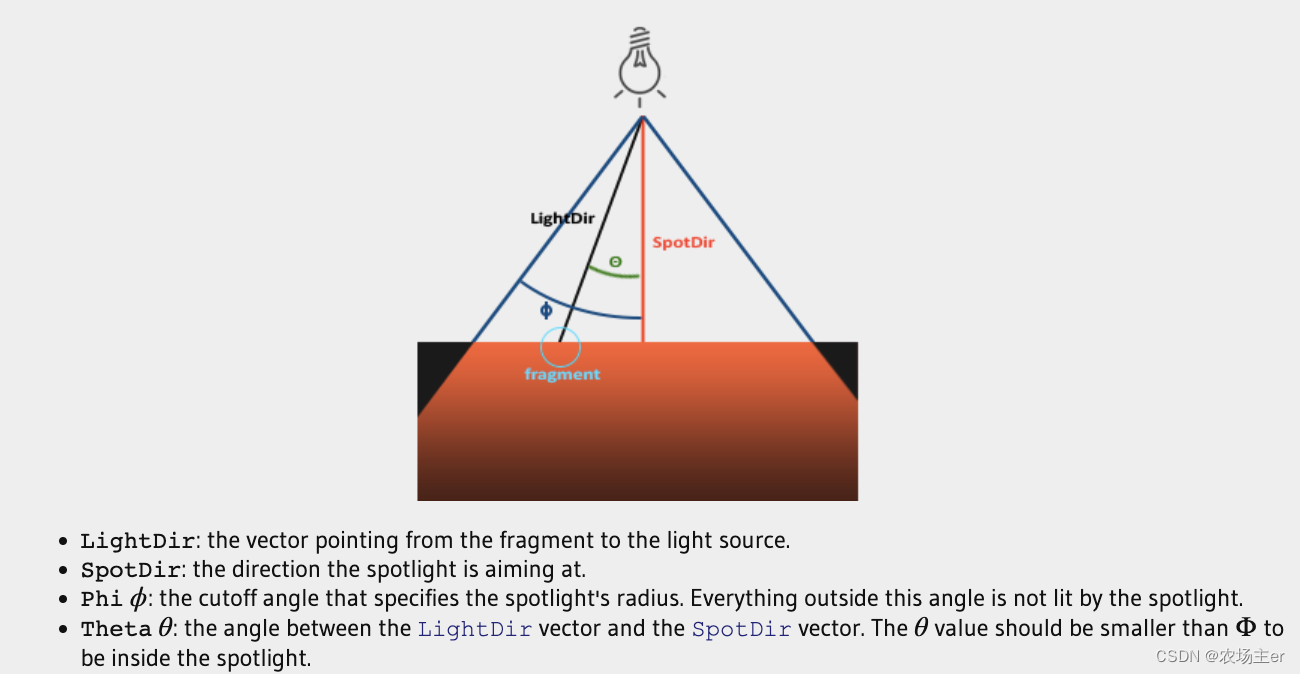
For each clip , We calculate whether the clip is between the tangent directions of the spotlight ( That is, in the cone ), Computation LightDir Vector and SpotDir Dot product between vectors , And connect it with Cutting angle ϕ Value comparison , If it meets the requirements , We will illuminate the fragment accordingly .
To create a spotlight that looks smooth at the edges , We need to simulate a spotlight Inner cone (Inner Cone) And a Outer cone (Outer Cone). We can set the inner cone to the one in the previous section , But we also need an outer cone , To darken the light from the inner cone , To the boundary of the outer cone .
To create an outer cone , We only need to define a cosine value to represent the focusing direction vector and the outer cone vector ( Equal to its radius ) The angle between . then , If a clip is between the inner and outer cones , I'll give it a 0.0 To 1.0 Strength value between . If the fragment is within the inner cone , Its strength is 1.0, If outside the outer cone, the strength value is 0.0.

The code implementation is as follows :
#version 330 core
out vec4 FragColor;
struct Material {
sampler2D diffuse;
sampler2D specular;
float shininess;
};
struct Light {
vec3 position;
vec3 direction;
float cutOff;
float outerCutOff;
vec3 ambient;
vec3 diffuse;
vec3 specular;
float constant;
float linear;
float quadratic;
};
in vec3 FragPos;
in vec3 Normal;
in vec2 TexCoords;
uniform vec3 viewPos;
uniform Material material;
uniform Light light;
void main()
{
// ambient
vec3 ambient = light.ambient * texture(material.diffuse, TexCoords).rgb;
// diffuse
vec3 norm = normalize(Normal);
vec3 lightDir = normalize(light.position - FragPos);
float diff = max(dot(norm, lightDir), 0.0);
vec3 diffuse = light.diffuse * diff * texture(material.diffuse, TexCoords).rgb;
// specular
vec3 viewDir = normalize(viewPos - FragPos);
vec3 reflectDir = reflect(-lightDir, norm);
float spec = pow(max(dot(viewDir, reflectDir), 0.0), material.shininess);
vec3 specular = light.specular * spec * texture(material.specular, TexCoords).rgb;
// spotlight (soft edges)
float theta = dot(lightDir, normalize(-light.direction));
float epsilon = (light.cutOff - light.outerCutOff);
float intensity = clamp((theta - light.outerCutOff) / epsilon, 0.0, 1.0);
diffuse *= intensity;
specular *= intensity;
// attenuation
float distance = length(light.position - FragPos);
float attenuation = 1.0 / (light.constant + light.linear * distance + light.quadratic * (distance * distance));
ambient *= attenuation;
diffuse *= attenuation;
specular *= attenuation;
vec3 result = ambient + diffuse + specular;
FragColor = vec4(result, 1.0);
}
Combine the above three light sources , The effect can refer to ->
边栏推荐
- Kotlin introductory notes (I) kotlin variables and non variables
- C language - input array two-dimensional array a from the keyboard, and put 3 in a × 5. The elements in the third column of the matrix are moved to the left to the 0 column, and the element rows in ea
- 编辑器-vi、vim的使用
- Summary of "reversal" problem in challenge Programming Competition
- 什么是防火墙?防火墙基础知识讲解
- np. allclose
- Characteristic Engineering
- Nodemon installation and use
- nodejs_ 01_ fs. readFile
- 【ManageEngine】如何利用好OpManager的报表功能
猜你喜欢
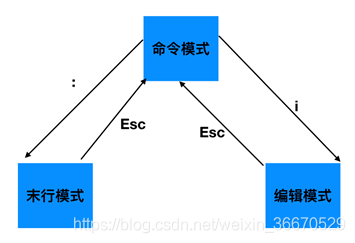
编辑器-vi、vim的使用
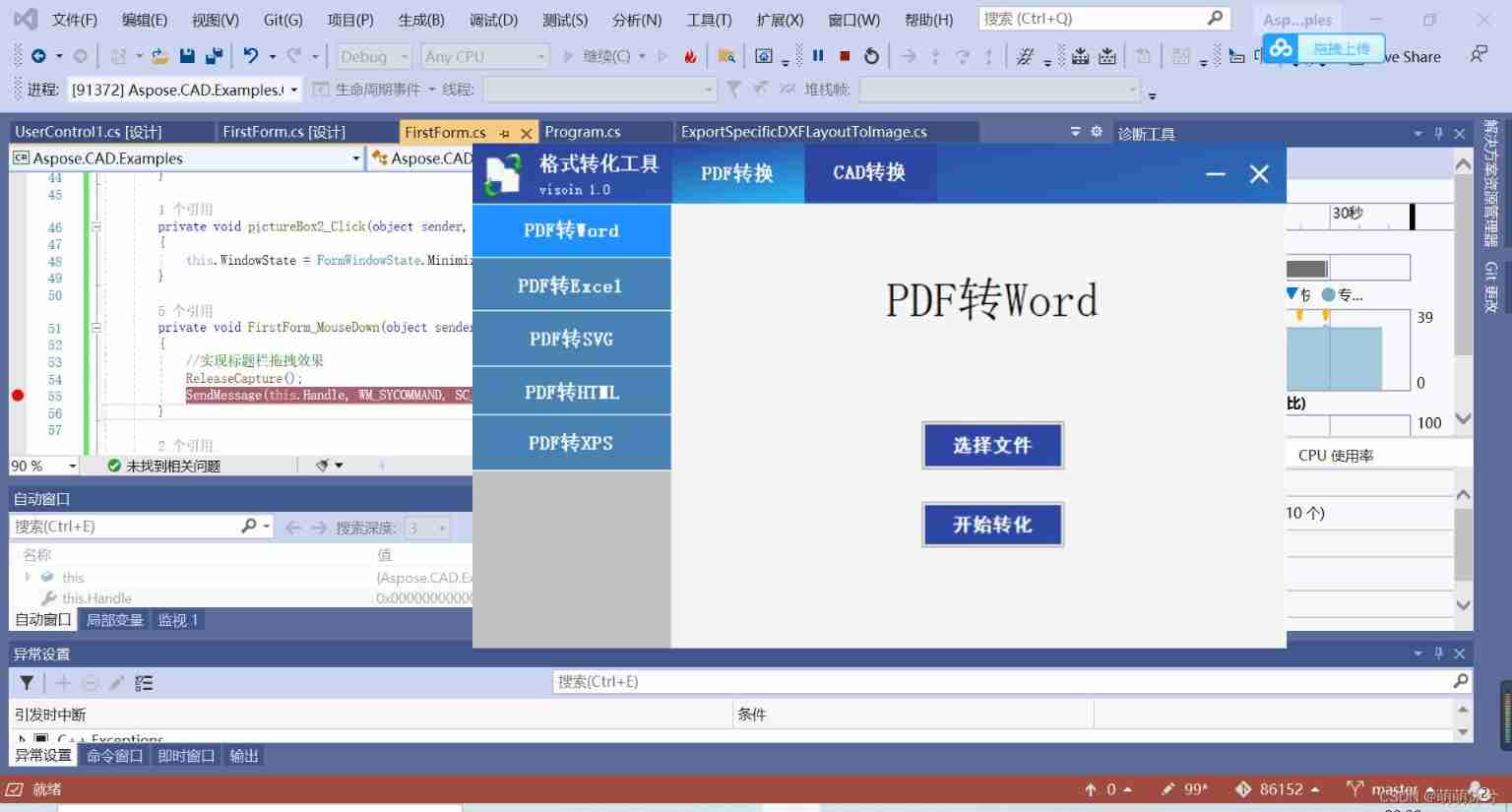
C form click event did not respond
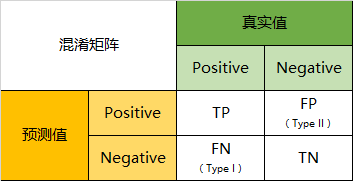
混淆矩阵(Confusion Matrix)

Hosting environment API

Shutter uses overlay to realize global pop-up
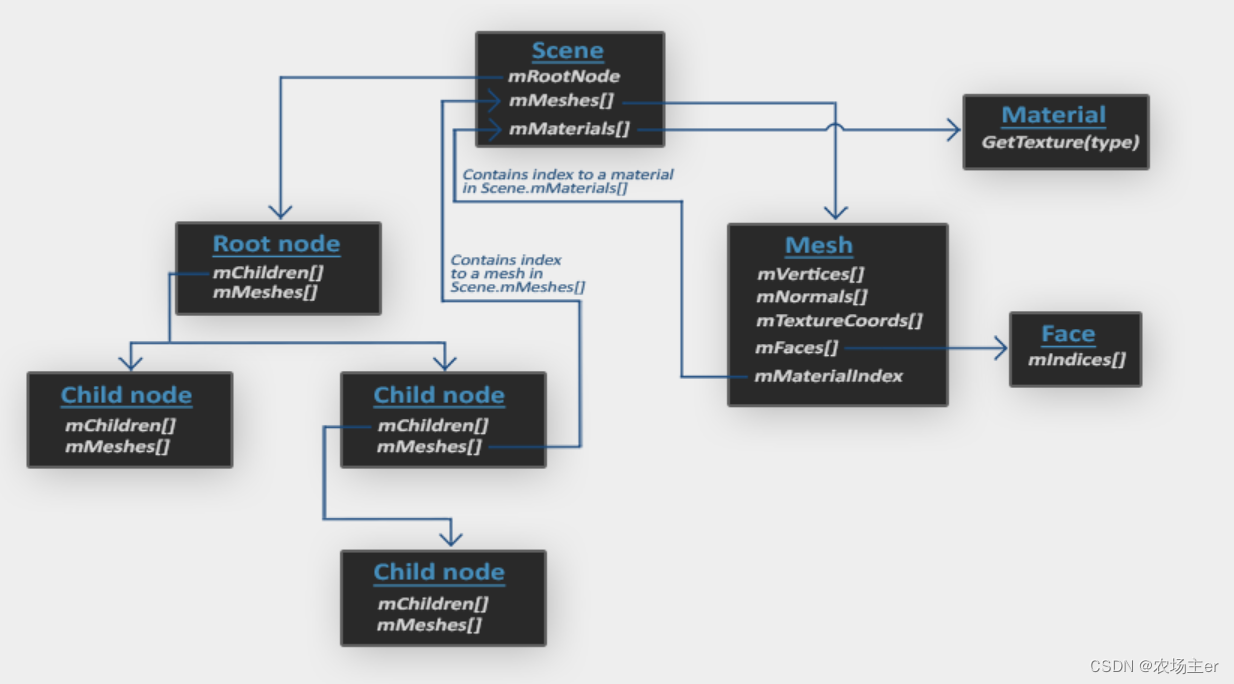
OpenGL - Model Loading

OpenGL - Lighting

Using request headers to develop multi terminal applications

嗨 FUN 一夏,与 StarRocks 一起玩转 SQL Planner!
![Rebuild my 3D world [open source] [serialization-1]](/img/74/b6253845b43bc18f425d57695fba7c.jpg)
Rebuild my 3D world [open source] [serialization-1]
随机推荐
Codeforces round 684 (Div. 2) e - green shopping (line segment tree)
Progressive JPEG pictures and related
【PyTorch Bug】RuntimeError: Boolean value of Tensor with more than one value is ambiguous
交通运输部、教育部:广泛开展水上交通安全宣传和防溺水安全提醒
Jenkins Pipeline 方法(函数)定义及调用
2310. 个位数字为 K 的整数之和
Kotlin introductory notes (II) a brief introduction to kotlin functions
阿里十年测试带你走进APP测试的世界
Can't find the activitymainbinding class? The pit I stepped on when I just learned databinding
Codeforces Round #648 (Div. 2) E.Maximum Subsequence Value
12. Dynamic link library, DLL
C#图像差异对比:图像相减(指针法、高速)
Kotlin introductory notes (III) kotlin program logic control (if, when)
Applet data attribute method
Applet customization component
一题多解,ASP.NET Core应用启动初始化的N种方案[上篇]
OpenGL - Model Loading
Shutter uses overlay to realize global pop-up
Codeworks round 638 (Div. 2) cute new problem solution
Add discount recharge and discount shadow ticket plug-ins to the resource realization applet